
|
The Mighty Caloris
- Click the image above for a larger view
- Full-Res JPEG (3130 x 3130) (2.6 MB)
- Full-Res TIFF (3130 x 3130) (9.8 MB)
Caption:
This is an MDIS mosaic of the mighty Caloris basin , Mercury's youngest large impact basin. Caloris has been filled by volcanic plains that are distinctive in color from the surrounding terrain. Subsequent craters have excavated low-reflectance material from beneath these volcanic plains, possibly giving clues to the composition of the basin floor. The basin interior has a complex tectonic history . The interior smooth plains have an area of 1.72 million km 2 (0.66 million mi 2 ), approximately the area of Alaska! Over 640 Rhode Islands would fit inside of this massive basin!
Click here for a full-resolution version of the mosaic (71 MB) to explore Caloris in all its glory.
Tune in Wednesday for a color mosaic of Caloris basin!
Instrument:
Mercury Dual Imaging System (MDIS)
Approximate Latitude Range:
3°N to 57°N
Longitude Range:
132°E to 196°E
Center Latitude:
31.5°N
Center Longitude:
162.7°E
Resolution:
250 meters/pixel
Scale:
Caloris basin is approximately 1525 km (948 mi.) across
Projection:
Orthographic
Background Info:
The MESSENGER spacecraft is the first ever to orbit the planet Mercury, and the spacecraft's seven scientific instruments and radio science investigation are unraveling the history and evolution of the Solar System's innermost planet. During the first two years of orbital operations, MESSENGER acquired over 150,000 images and extensive other data sets. MESSENGER is capable of continuing orbital operations until early 2015.
For information regarding the use of images, see the MESSENGER image use policy .
Cataloging Keywords:
| Name | Value | Additional Values |
|---|---|---|
| Target | Mercury | |
| System | ||
| Target Type | Planet | |
| Mission | MESSENGER | |
| Instrument Host | MESSENGER | |
| Host Type | Orbiter | |
| Instrument | Mercury Dual Imaging System (MDIS) | |
| Detector | ||
| Extra Keywords | Crater, Grayscale, Impact, Radio, Volcano | |
| Acquisition Date | ||
| Release Date | 2015-02-23 | |
| Date in Caption | ||
| Image Credit | NASA/Johns Hopkins University Applied Physics Laboratory/Carnegie Institution of Washington | |
| Source | photojournal.jpl.nasa.gov/catalog/PIA19213 | |
| Identifier | PIA19213 | |
